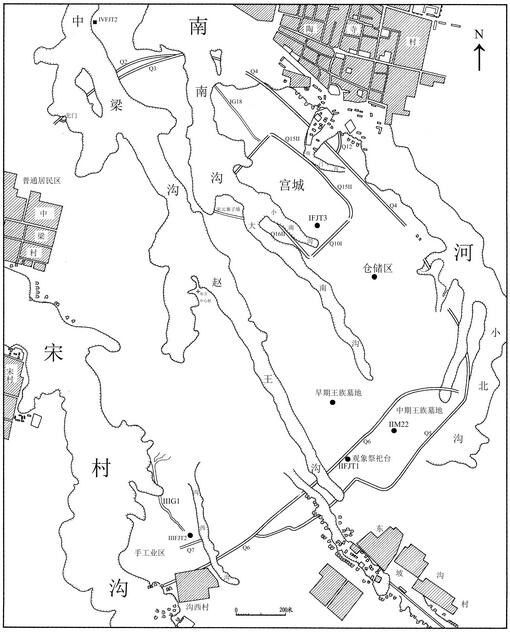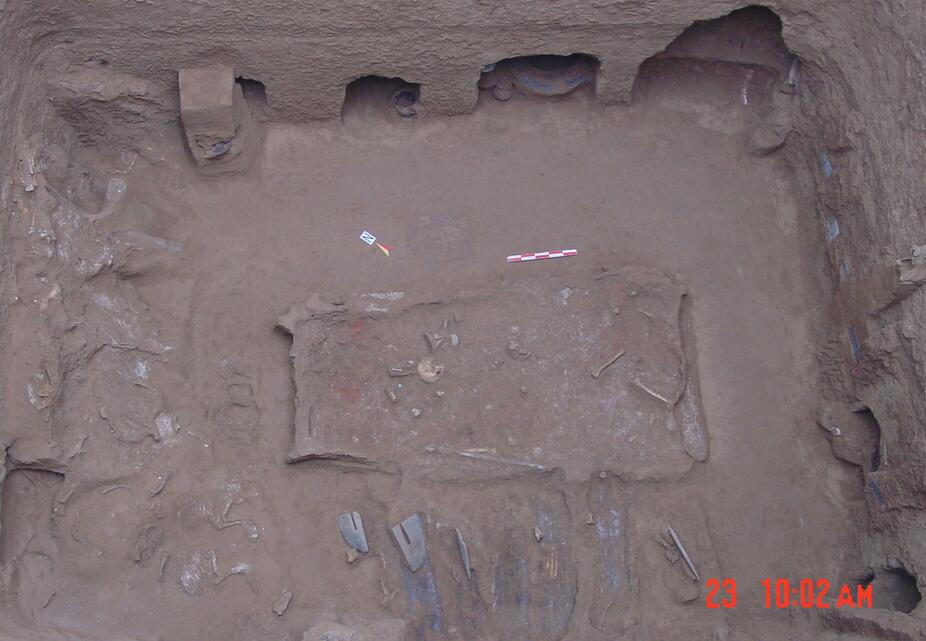Taosi: the Beginning of "China" and "Central Plain"
From:Shanghai Archaeology Forum NetWriter:Date:2017-12-15
In order to examine the origins of Chinese civilization and the formation of early states, the Institute of Archaeology, the Chinese Academy of Social Sciences, the Archaeological Institute of Shanxi Province and the Linfen Municipal Center of Cultural Relics have been conducting archaeological excavations and research at the site of Taosi, Xiangfen County, Shanxi Province since 1978. Almost forty years of archaeological pursuits have yielded substantial results on topics such as the characteristics of this city state, including the chronological timeline of its rise and fall, its social structure, holistic understanding of the settlement pattern that centers around Taosi, and the ideology and culture of Taosi’s population. Between 2002 and 2016, the Origin of Chinese Civilization Project played a particularly large role in the promotion of excavation and research at Taosi. From 2013 to 2017, the Taosi Archaeological Project was included in the State Administration of Cultural Heritage’s Large Site Protection Project and was named an “Innovative Project of Philosophy and Social Science” bye the Chinese Academy of Social Sciences.The excavations and research at Taosi guided by the archaeological concept of the“city state.” In addition to coring and excavating, the Taosi Archaeological project also utilized technologies such as total station, aerial photography, magnetometer, and ground penetrating radar. The post-excavation research of the site remains include archaeometry, zooarchaeology, paleobotany, ancient DNA analysis, strontium isotopic analysis, paleo-dietary analysis, pollen analysis, neutron activation analysis of pottery, phytolith analysis, tree species analysis, metallurgy, human-landscape relationship study, paleogeology, paleography, astronomical archaeology, cognitive archaeology and the study of historical texts. The results of these studies not only enriched our understanding of Taosi, but also allowed for more in-depth study of the relationship between the site and its remains, contributing to the increasing international attention the site has received.

The early period of Taosi dates from 4300 BP to 4100 BP and consisted of a total area of 1,600 square kilometers. The core of early Taosi was composed of a 130,000 square meter palatial zone and a smaller lower elite residential city (measuring 100,000 square meters) located on the palatial zone’s southern edge. The palatial zone included a right-angled gate with a complex structure and an annex suspected to be an“ice house.” Double-roomed subterraneous houses were found in the lower elite residential zone. The eastern and western sides of the palatial zone were non-elite residential zones, and there was a large storage area in the eastern edge of the palatial zone. The royal cemetery was located in the southeastern region of the palatial zone. Six royal burials were excavated with more than 100 grave goods such as painted dragon pottery pan-plates, painted ritual pottery vessels, painted lacquer vessels, jade yue axe, large kitchen knives, and utilitarian pottery vessels. There were more than 10 elite burials with more than 10 mortuary goods including painted utilitarian pottery and musical instruments such as stone chimes, pottery drums, and hollow-trunk drums covered in animal hide. Very few mortuary items were found among the 1000 plus small burials. During the early period, there was a clear hierarchical structure with an apparent gap between different social statuses. The early period of Taosi possessed the structure and nature of an incipient city state.
The middle period of Taosi dated to 4100BP to 4000BP. At this time, the palatial zone was still in use and multiple palatial structures were constructed within it. The largest core building measured 8000 square meters and included minimally a front and a rear palatial hall. Based on the remains of post-holes and their distribution, it can be estimated that the front palatial hall measured approximately 286 square meters. During this period, the lesser elite residential city from the early period was abandoned and an outer city measuring 2,800 square kilometers was constructed. The kingly cemetery and the sacrificial ritual platform were located in the southeastern city and measured 100 square kilometers.
A middle Taosi period kingly tomb, IIM22, measured 5 meters in length, 3.7 meters in width, and 7 meters in depth. This is the largest tomb excavated to date from the Taosi cultural period. Despite the destruction resulting from political turmoil during the late period of Taosi, approximately 100 grave goods were recovered from tomb, IIM22 including jade, painted pottery vessels, lacquer vessels, bone objects, and sacrificial pigs that had been halved. Among the grave goods were six jade yue axes that symbolized royal and military power. These axes were associated with boar mandibles, which when taken together, express “governing of the state, in which military troops were raised even in the absence of a war. This is a philosophy of government that is considered a virtue throughout the history of Chinese civilization. A lacquer sundial and associated measuring tools found in the tomb indicate the important contributions of the royal calendar system, and the political status and legitimacy afforded by the standardized measurement of 1.6 chi.
The sacrifical ritual platform measured 1.7 square kilometers. Extending from Q6, the southern wall of the southeastern city of the outer city, the ritual platform was constructed with rammed-earth blocks in an arc shape oriented to the southeast. Based on the results of astronomical archaeology, this platform was not only a structure dedicated to the celestial cult during the middle Taosi period, but based on the rammed earth structure, it could also have been a celestial observatory aligned with stone columns. The sunrise observational point was on the ridge of Taershan (or Chongshan) located seven thousand meters to the northeast-southeast direction of Taosi. From the position of the observatory and the observatory points, it was postulated that one solar year was divided into 20 terms. Exclusive knowledge of science and religious power would have provided the basis for the authority of Taosi royalty, thereby allowing them to control politics, the economy, and social life at Taosi. The celestial observatory at Taosi served as the earliest observatory in the archaeological world, and the 20 solar year terms was the most meticulous calendar system used in the world 4100 years ago.

The craft production area of the middle Taosi period was located south of the outer city wall and took up an area of 200 square kilometers. The area produced stone tools and ceramic vessels, and would have been strictly supervised and controlled by officials.
North of the city of Taosi, there was a rectangular rammed-earth foundation with an area of approximately 1.4 square kilometers that was surrounded by a large body of water. There were three postholes in the top of the foundation arranged in a “品” pattern. This structure mirrors the “Altar of the Earth in the middle of a pond” structure that is recorded in historical documents, meaning the foundation could have been used for ritual performances dedicated to the Earth. This rammed-earth altar was constructed in the early period of Taosi, was expanded during the middle period, was partially destroyed during the late-middle period, and was rebuilt and further expanded during the later period.
Based on the current findings, the residential area for non-elite commoners during the middle Taosi period was mainly located in the northwestern part of the outer city and measured 20square kilometers. During the middle period, Taosi meets all the functional criteria of a city state.
Geological and geomorphological surveys of Taosi indicate that the present-day Nangou stream – Danangou was a main avenue during the early period. It ran horizontally south of the palatial zone, from northwest to southeast. The present-day Zhaowanggou stream – Zhonglianggou stream was the main avenue during the middle period at the site. It ran horizontally through the center of the outer city, originating in the southeast near the sacrificial observation platform and terminating in the northwest at the Alter of the Earth, while splitting off in between effectively linking the outer city to the northern gate.
During the late period (4000BP-3900BP), Taosi was likely conqured by foreign polities. The site experienced brutal and violent political retaliation and major political turmoil; it became a colony and lost the functional properties of a city state. During a late phase of the late period, the local political power at Taosi was temporarily restored; the palatial zone and the sacrificial observation platform in the northern section of the site were restored, and a city gate was constructed in the eastern section of the palatial zone’s southern wall. The eastern and western pillars of the newly constructed city gates were equipped with military defense systems, providing one of the earliest examples of city watchtowers in history. Unfortunately, local political power at Taosi once again declined shortly after these construction projects and Taosi was eventually abandoned.

To date, three examples of cinnabar scripts on pottery have been discovered from the palatial zone of Taosi. All of the scripts were dated to the late Taosi period and were written on fragments of oblate hu jars. It is widely agreed upon in the academic world that one of the characters “文,” shares a common origin with the character “文” in Shang and Zhou oracle-bone script and bronze inscriptions. Another character “尧” appeared three times, though only one of them was complete and two were damaged. Some explanations of the character include “city,” “sun,” and “tang.” The bone plow in the elite tomb IIM26 from the middle Taosi period was carved with a single character “辰,” which could be the incipient form of “农,” meaning agriculture. Overall, these characters at Taosi seem to have the same origins as the Shang and Zhou Dynasties oracle-bone and bronze inscriptions. From the archaeological evidence at Taosi, we believe that the modern day Chinese characters could have originated from the Taosi culture.
Five copper items were yielded from Taosi, including a copper pen basin rim dating to the middle period that was excavated from the rammed-earth foundation of the core palatial zone, and a copper bell, a gear-wheel shaped copper artifact, a copper ring, and copper toad excavated from the stratigraphic layers dated to the late Taosi period. All these copper items were used for ritual purposes, setting the stage for the use of bronze ritual items in the later periods of Chinese civilization.
Moreover, based on the regional archaeological surveys in the region, the Taosi city state was surrounded by at least two other Taosi culture site clusters to the north and south. Each of these surrounding site clusters anchored on a respective center site measuring 200 square kilometers. Each cluster was made up of a center and localized subsidiary sites, contributing to a five-tier settlement structure and a four-tier hierarchical internal social system. The Taosi culture therefore clearly had a state-level political structure.
The site of Taosi was equipped with the properties of a city state, and has the earliest occurrence of a palatial zone paired with an outer city in China, a “rites and music” system, a palatial system, the earliest writing, the earliest copper ritual items, and the earliest celestial observatory and sundial. This unprecedented repertoire of archaeological remains found at a prehistoric site signifies the role of Taosi as the center of the formation of Chinese civilization. Taosi, the earliest state in the Middle Yellow River Valley, marked the beginning of the concept of the“Central State (Zhongguo),” meaning both the capital of the land and the kingdom in the center of the land. Taosi is where the concept of the Central Plains began.

